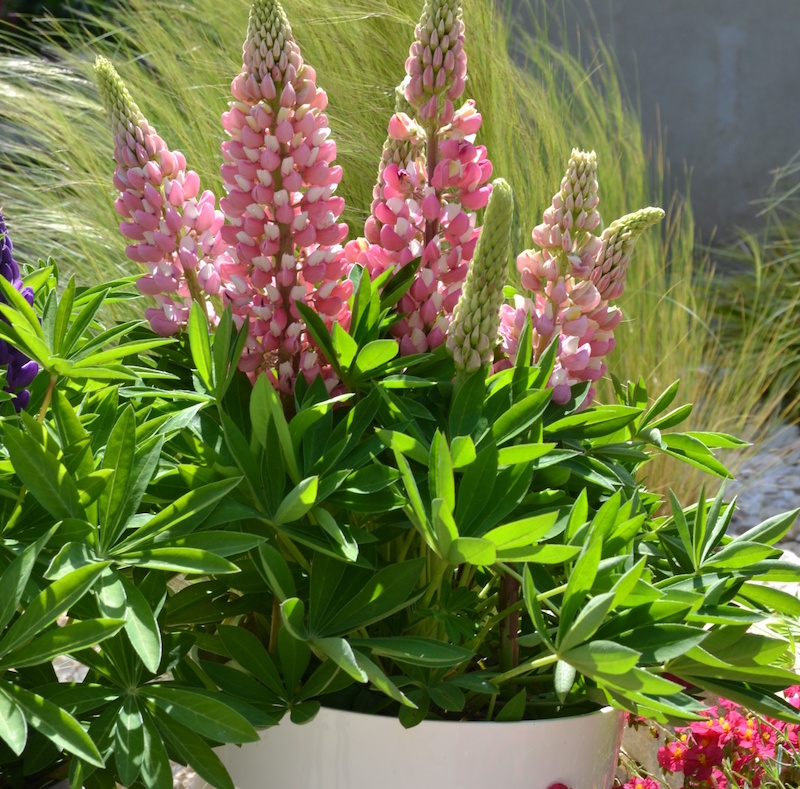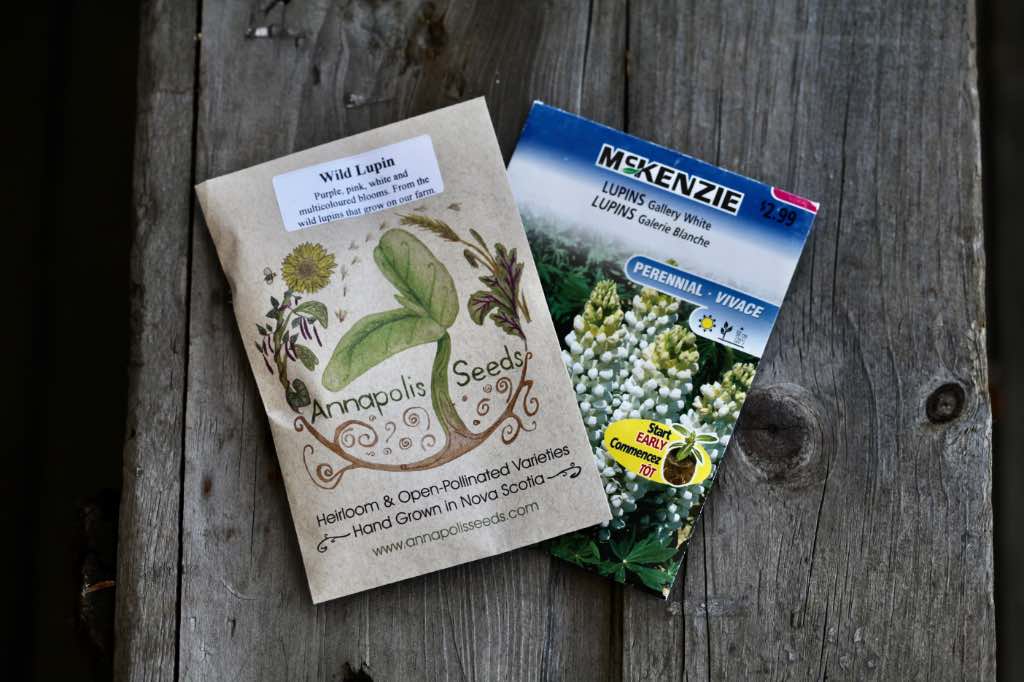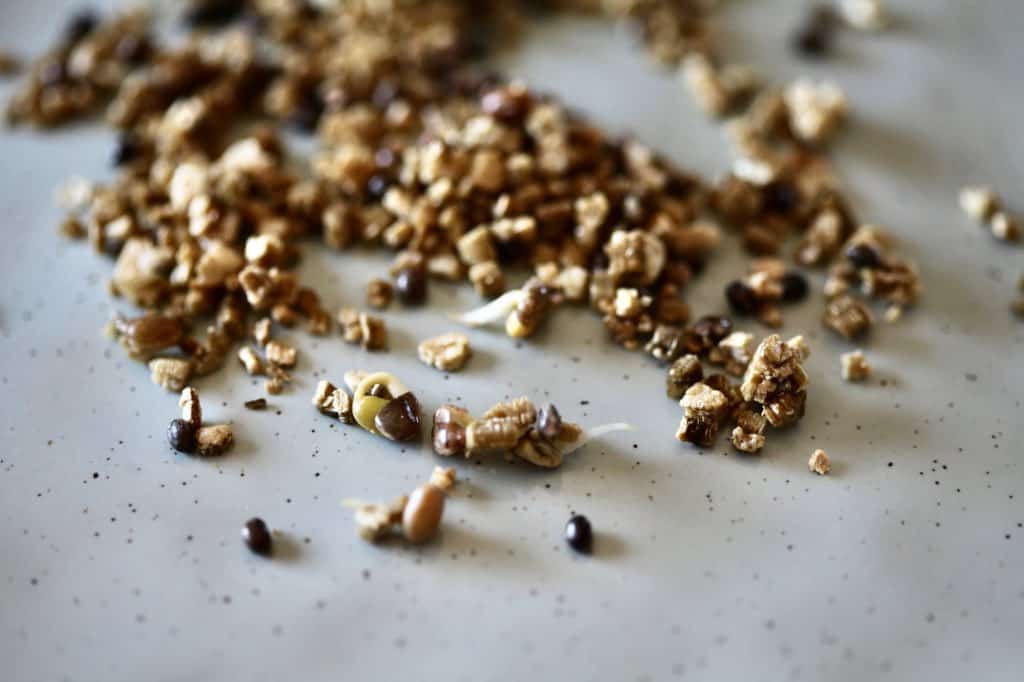Have you ever seen drifts of beautiful lupines growing along highways and roadways in late spring? Here in Nova Scotia we are blessed with a beautiful show of late spring lupines, growing wild in ditches and meadows, decorating our landscapes with a wildflower palette of soft pinks, purples, and yellows.
Have you ever wanted to have some of these pretty flowers growing in your own garden? I will share a few tips on growing lupines and reasons we love them!
Lupine, or lupin (lupines polyphyllus) is considered a wildflower here in Nova Scotia, escaped from cultivation, and taken up home on roadsides and meadows.
It remains a popular perennial flower in our gardens as well, and looks wonderful in mass plantings or dispersed with other cottage garden flowers.
Lupines grow approximately 36 – 60 inches tall, and produce striking pastel coloured spike like blooms in shades of pink, purple, blue and yellow.
Lupin foliage is whorl-like in structure. Raindrops sitting on lupine leaves will bead and glisten like sparkling pearls.
Lupine is a beautiful perennial flower that adds vibrant color and texture to any garden With its spiky blooms and attractive foliage, lupine makes a stunning addition to container plantings But can lupine grow successfully in pots? The answer is yes! With the right care and conditions, lupine can thrive when grown in containers.
Selecting the Right Pot
When choosing a pot for lupine, opt for something at least 12 inches wide and deep. This will allow ample room for root development. The pot should have drainage holes to prevent soggy soil. For outdoor pots, select a durable material like terra cotta or plastic that can withstand extreme weather. Look for pots with saucers to catch excess water.
Providing Proper Soil
Lupine thrives in loose, sandy soil amended with compost. Avoid heavy clay soils that retain too much moisture. The ideal pH range is slightly acidic at 6.0-6.5. For potting mix, use a commercial blend designed for perennials and add extra perlite or vermiculite to improve drainage. Mix in some slow-release fertilizer at planting time.
Choosing the Best Location
When growing lupine in pots, situate them in an area that receives full sun to partial shade. At least 6 hours of direct sunlight daily is ideal. Select a spot that is sheltered from strong winds, which can damage the brittle stems and flower spikes.
Watering Recommendations
Lupine has relatively shallow roots and requires evenly moist soil. Allow the top 1-2 inches of soil to dry out between waterings. During hot, dry weather you may need to water every few days. Check the soil frequently and water when the top layer is dry. Avoid saturating or overwatering the soil.
Feeding Requirements
Use a balanced liquid fertilizer every 2-3 weeks during the growing season. Look for products designed for flowering plants. Slow-release pellet fertilizers incorporated into the potting mix will provide nutrients for several months. Avoid over-fertilizing lupine, which can cause leaf burn.
Pruning for Success
For fuller, bushier growth, prune back the flower stems after the initial spring bloom. This encourages the plant to produce more side shoots. You can also prune off any damaged or diseased stems as needed. Cut each stem just above a leaf node. Avoid shearing the plant like a hedge.
Caring for Lupine in Winter
Lupine dies back each winter and goes dormant. Stop watering and trim away any dead, brown foliage in autumn. Move the pots to a sheltered area protected from heavy frost and freezing winds. A cool garage or unheated shed is ideal for overwintering dormant lupine pots.
Troubleshooting Common Problems
Lupine grown in pots may develop issues like powdery mildew root rot, and aphids. Powdery mildew looks like white powder on the leaves and stems. It thrives in humid conditions. Improve airflow and avoid wetting the foliage when watering. Root rot is caused by overly moist soil. Let the soil dry out between waterings. Aphids are small green insects that suck plant sap. Knock them off with a strong spray of water or use insecticidal soap.
Tips for Encouraging Flowers
For prolific flowering, lupine needs cool nighttime temperatures around 50-60°F when buds are forming. Avoid applying nitrogen fertilizer, which promotes leafy growth over flowers. Pinching off the first flower spikes during the first season will allow the plant to focus energy on root development. Well-established roots will support better flowering the following season.
Choosing the Best Lupine Varieties
Some top lupine varieties for containers include ‘Mini Gallery’ mix with short, 12 inch flower spikes in pink, red, white, and blue. ‘Chandelier’ has showy, hanging blooms on 20 inch stems. ‘Tutti Frutti’ is very compact at 8-12 inches tall with a rainbow of flower colors. ‘My Castle’ is known for dense, richly-hued spikes up to 18 inches tall. Consult your local nursery to select the best regional varieties.
Displaying Lupine Pots in the Landscape
Use lupine pots to add vertical interest along borders, in flower beds, flanking entryways, or lining garden paths. Place them near patios and decks where the flowers can be admired up close. Try combining different lupine varieties and colors for a dramatic effect. Include companion plants like catmint, coral bells, and ornamental grasses. With proper care, potted lupines will flourish, providing stunning color from spring through summer.

Tip #8: Deadhead Lupines
Lupines produce their first flush of flowers in June and July.
If you deadhead the old flowers after this first flush, your lupine plants may rebloom, although the second flush of flowers will be smaller than the first.
Individual flowers start to die back from the base of the bloom first. Deadhead the blooms after two thirds of the flower head has died back.
Deadheading the old flowers gives a clean look to the plants, and encourages fresh growth of leaves, and possibility of more blooms.

Tip # Growing Lupine From Seed

Stratification:
Lupine seeds benefit from a period of cold stratification.
We bought wild lupine seeds from Annapolis Seeds this year. They recommended that the seeds have a period of cold stratification of at least 1-2 weeks in moist paper towel.
We chose moist vermiculite in a baggie, which worked just as well.
The seeds started to germinate in the fridge after several weeks.
Scarification:
Scarification is the process of cracking the hard shell of a seed.
This technique can be helpful to germinate lupine seeds.
Not all seeds need scarification, however seeds with hard coats such as lupines may benefit from this technique.
You can scarify the seed coat in a number of ways.
You can crack the seed coat by making a nick in the hard outer coat with a knife or a pair of clippers.
Be careful to only nick the shell of the seed and not the soft inside parts.
Another option is to rub the coat with something coarse, like a file or a piece of sandpaper

Soaking Lupine Seeds:
Some people soak their lupine seeds for 24 hours prior to planting.
This allows for rehydration of the seeds, and helps with germination.
Scarification prior to soaking is helpful.
If you are cold moist chilling in the fridge, you do not need to soak. Cold moist chilling does the same thing as soaking. It provides rehydration, as well as the cold chill effect, which simulates winter.
Starting Lupine Seeds Indoors:
After stratification, the lupine seeds are ready to be planted.
We start our seeds indoors in trays, in a soilless mix.
After planting, they go onto the heat mat, until 60 percent of the seedlings have sprouted.
Then the seedlings are placed under grow lights until ready to be hardened off.
How Deep Do you Plant The Lupine Seed?
Lupine seeds are planted 1/8 “ deep, and are covered with a light layer of soil or vermiculite.
Growing and Caring for Lupins in Containers
FAQ
Do lupins do well in pots?
Lupins are members of the legume family, which means they have a large central tap root which, if disturbed, may not grow as well once resituated. They can be grown in pots, but form much larger and healthier plants if planted directly in the soil.
Can you grow lupine in a container?
Planting Lupine in Pots
The container-grown plants are cold hardy and can withstand a light, unseasonably late frost. Choose a location with full sun or partial shade to promote the best blooming. Too much shade will result in smaller flowers and weak foliage, which is susceptible to aphid damage.
Do lupines like sun or shade?
Light: Full sun is preferred. Lupine can grow in part shade, but flowering will be lessened. Soil: Lupine needs well-draining soil above all else. They prefer soil on the acid side and will not tolerate high levels of alkalinity or water-logged conditions.
How do you plant potted lupines?
Potted lupine plants are typically perennial cultivars that you can put in the ground immediately in the spring. Space plants about 2 to 3 feet apart, and loosen the soil deeply to accommodate the long taproots. Amend the planting hole with organic matter, if necessary, to improve drainage.
Can lupine grow in pots?
Yes, lupine can grow in pots. Lupines are hardy plants, and they can tolerate a wide range of temperatures and soil conditions. Lupines need plenty of sunlight, and they require well-drained soil. It is important to water regularly and fertilize occasionally.
Do lupins need a large pot?
1. Provide a Large and Wide Pot/Container to Plant Lupins Mature lupins are tall plants, some towering over 5 feet high. However, the reason why you need a large pot is primarily to accommodate their developing deep roots. If these were forced to grow in shallow and small vessels, the plant would eventually get rootbound and have growth problems.
How to grow lupines in winter?
The drainage of the pot needs to be excellent. Depending on where you garden, the pot material needs to be able to endure the winter without cracking, flaking, or breaking. Composite resin and plastic pots are the most durable for cold climates in zones 4-6. An all-purpose potting soil is perfect for containers of Lupines.
How big should a potted Lupin be?
The size of the pot will partly depend on whether the potted lupin is to be an indoor or outdoor lupin. Obviously, you can use bigger pots outside, I would recommend at least a 45cm pot or above. If growing inside then lupins will be happy in anything above a 30cm pot.
What is the best potting soil for lupines?
Composite resin and plastic pots are the most durable for cold climates in zones 4-6. An all-purpose potting soil is perfect for containers of Lupines. The mix needs to be lightweight and free draining, so that the roots do not spend time sitting in waterlogged soil.
Are lupines cold hardy?
Lupines are cold hardy and survive winters in some of the coldest growing zones. Growing the plants in pots makes it easy to move them to a sheltered location from prevailing winter winds and storms. If the containers are too large to carry, the pot can be wrapped in burlap or horticultural fleece layers to insulate the root system.
